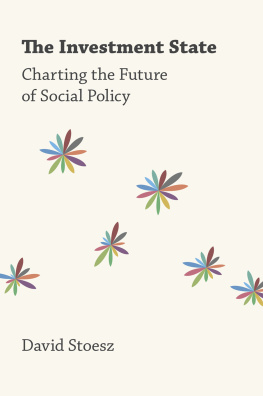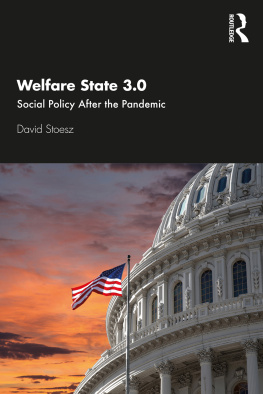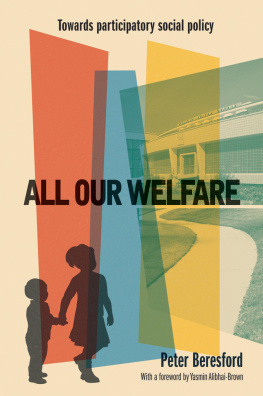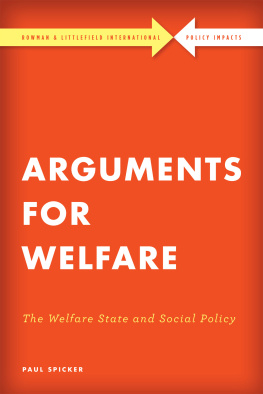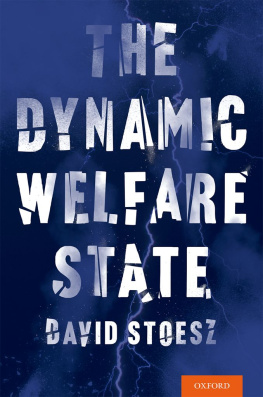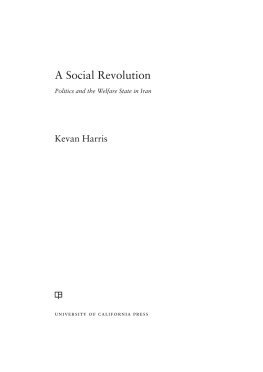The Investment State

Oxford University Press is a department of the University of Oxford. It furthers the Universitys objective of excellence in research, scholarship, and education by publishing worldwide. Oxford is a registered trade mark of Oxford University Press in the UK and certain other countries.
Published in the United States of America by Oxford University Press
198 Madison Avenue, New York, NY 10016, United States of America.
David Stoesz 2018
All rights reserved. No part of this publication may be reproduced, stored in a retrieval system, or transmitted, in any form or by any means, without the prior permission in writing of Oxford University Press, or as expressly permitted by law, by license, or under terms agreed with the appropriate reproduction rights organization. Inquiries concerning reproduction outside the scope of the above should be sent to the Rights Department, Oxford University Press, at the address above.
You must not circulate this work in any other form and you must impose this same condition on any acquirer.
Library of Congress Cataloging-in-Publication Data
Names: Stoesz, David, author.
Title: The investment state : charting the future of social policy / David Stoesz.
Description: New York : Oxford University Press, 2018. |
Includes bibliographical references and index.
Identifiers: LCCN 2017049327 (print) | LCCN 2018013384 (ebook) |
ISBN 9780190881245 (updf) | ISBN 9780190864842 (epub) |
ISBN 9780190864835 (hardback)
Subjects: LCSH: Public welfare. | Welfare state. |
Social policy. | BISAC: POLITICAL SCIENCE /
Public Policy / Social Services & Welfare.
Classification: LCC HV31 (ebook) |
LCC HV31 .S796 2018 (print) | DDC 361.6/1dc23
LC record available at https://lccn.loc.gov/2017049327
How selfish soever man be supposed,
there are evidently some principles in
his nature, which interest him in the
the fortune of others.
Adam Smith, The Theory of Moral Sentiments
CONTENTS
This book proposes a new way of thinking about social programs, premised on investment, which stands in contrast to a previous era when entitlements were regnant. Multiple reasons justify such an exercise: historically, the welfare state of the 20th century, which was built on the foundation of an industrial economy, seems poorly adapted to a 21st-century information age. Socially, profound demographic shifts, especially an aging population, increasing numbers of women in the labor force, and surging immigration pose challenges for traditional programs. Economically, the legacy of social entitlements, which has been addressed through deficit spending, is untenable insofar as social entitlements squeeze out essential discretionary programs. Politically, the demise of the Left, signified by Brexit, the election of Donald Trump to the presidency, and less successful populist movements in Europe and Australia continues a conservative vector in social policy. The confluence of these factors increases the need to reassess national social programming.
Indeed, 2016 may well have proven a pivotal year, signaling public defection from the designs of liberal/centrist elites, who configured the welfare state regimes in developed nations. If so, significant adjustments can be expected as social programs are reconsidered in relation to citizen expectations and aspirations. These events spell opportunity not only for the larger welfare states, such as the United States and the United Kingdom, but also their smaller counterparts in Canada and Australia. The logic of social investment suggests that those nations configuring social policy strategically will prosper over the long run compared to those that are indiscriminate.
In this respect, The Investment State is a sequel to The Dynamic Welfare State, which included a theory of welfare state decline, by envisioning a new paradigm for social programs. The Dynamic Welfare State presented five interacting elements that subverted the governmental welfare state: rising Together these created a vortex of credibility as citizens, taxpayers, and lawmakers lost confidence in public social programs. At the same time welfare states eroded, a successor has become evident as a quite different vocabulary has emerged to justify social programs: capability, employee benefits, evidence-based programs, democracy, and inclusion. These represent a qualitatively different paradigm with respect to social infrastructure, which I call the investment state.
The investment state not only solves a primary puzzle that has perplexed a degraded welfare stateupdating social policy so that it is more congruent with an aging population, increasing numbers of women in the workforce, and surging immigrationbut also represents a disruptive innovation. Given embedded stakeholders of the welfare state, including beneficiaries, administrators, professional staff, and advocacy organizationsindeed, the entire liberal Democratic regime in Americathe transition to an investment state represents a sea change and is bound to be fraught with tension, even vilification. Public service staffs, not only protected by civil service but also union collective bargaining agreements (and, in some instances, further insulated by professional licensing), stand to lose income and authority if programming is redefined. Another group of objectors will be tenured university professors who use their lecterns to propagandize to students about the alleged virtues of social programs, particularly poverty programs. Classified as liberal, labour, or leftist, these groups have a stake in the status quo, however inadequate extant programs may be. The election of Donald Trump to the presidency may prompt progressives to wax nostalgic about liberal Democratic achievements of the past, but replicating these in the future is unlikely.
Thus, it behooves those concerned about social and economic justice to reflect on the current circumstance. Denial places progressives not only on the wrong side of history but also the wrong side of reality. Fundamentally, a nations social infrastructure warrants reconsideration if it is to honor its obligations to current and future generations. Simply put, the status quo no longer provides a confident guide to the future. Regardless of preferences about social programs, the welfare state will be reconfigured; the seminal questions becoming, By whom? In what form? and When?
To skeptics of the transition from a welfare state to an investment state, two observations are relevant. First, reforming social programs is congruent with pragmatism. Toward the end of the 19th century, pragmatists were psychologists who observed that people were creatures of habit, who, when encountering disruptions in daily activities, contrived thought experiments to solve problems. By aggregating individual experiences, social policy can be understood as collective efforts to solve problems that are beyond individual control. Few would question the value of community schools, fire and police departments, or public health agencies. On a larger scale, problems of immigration, pollution, and global trade justify initiatives that are national in scope. A byproduct of a polarized polity, solutions to such problems have been frustrated by ideologues who erect obstacles to debate and compromise, which is regrettable. The conventional wisdom holds that political parties are combatants in the ideological arena; yet, a more sanguine view is possible, if not necessary: parties are stewards of the public good, however differently that is divined over time.

